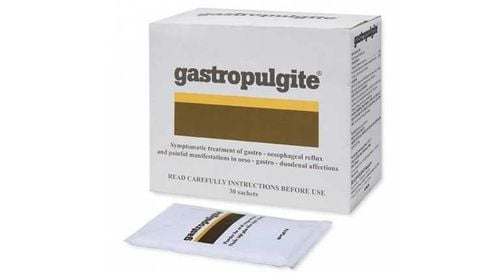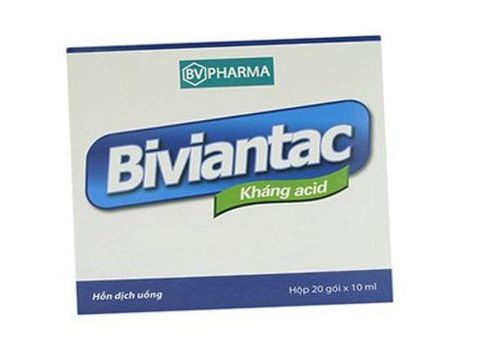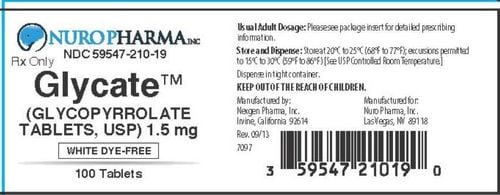This is an automatically translated article.
Pantostad 40 is a medicine commonly used to treat diseases of the stomach, duodenum, and eosinophilic esophagitis. To better understand what Pantostad is? What diseases does Pantostad 40 treat? What are the harmful interactions of Pantostad 40? What is the correct way to drink? What features should be noted when using? The following article will help you better understand Pantostad 40.1. What is Pantostad 40?
Drug Pantostad 40 The main ingredient is Pantoprazole, which is used to treat inflammatory diseases of the esophagus caused by gastroesophageal reflux disease in adults and children 12 years of age and older. In combination with appropriate antibiotic therapy The drug is also used to eradicate Helicobacter pylori ( H. pylori ) in patients with H. pylori ulcers, duodenal ulcers, peptic ulcers, Zollinger–Ellison syndrome and other pathological hypersecretory conditions.
In addition, each tablet also has a sufficient number of excipients such as: carmellose sodium, eudragit L30D-55, maltitol, anhydrous sodium carbonate, triethyl citrate, calcium stearate, yellow opadry and crospovidone.
LD Co., Ltd. Stada - Vietnam manufactures this product.
Has registration number VD-14853-11.
Medicines are made in Vietnam.
Preparation of drugs in the form of film-coated tablets.
Packing:
Box of 4 blisters, blister has 7 tablets. Box of 2 blisters, blisters with 7 tablets Box of 3 blisters, blisters with 10 tablets, Box of 5 blisters, blisters with 10 tablets
2. What are the uses of Pantostad 40?
2.1. Pharmacodynamic properties Pharmacotherapeutic group: Proton pump inhibitor, ATC code: A02BC02
Mechanism of action
Pantoprazole is converted to the active form in the acidic environment of parietal cells, where it inhibits the enzyme H +, K + -ATPase, to the final stage of hydrochloric acid production in the stomach. The dose-dependent inhibition of the drug affects both basal and excitatory acid secretion. Within 2 weeks symptom relief is achieved in most patients. H2-receptor blockers, like other proton-pump inhibitors, when treated with pantoprazole reduce gastric acidity, which corresponds to a decrease in acidity, thereby increasing gastrin. Reversible with increased gastrin. When pantoprazole binds to radioenzymes at the cellular receptor level, it can inhibit hydrochloric acid secretion independent of stimulation by other substances (acetylcholine, histamine, gastrin).
Pantoprazole is a transposable benzimidazole and inhibits gastric hydrochloric acid secretion by specific blockade of parietal cell proton pumps.
Pharmacodynamic effects
Fasting gastrin values are increased with pantoprazole administration. In short-term use, in most cases they do not exceed the upper limit of normal. During long-term treatment, gastrin levels double in most cases. However, the excessive increase occurs only in a few isolated cases. As a result, a mild to moderate increase in the number of specific endocrine cells (ECL) in the stomach was observed in rare cases with long-term treatment (simply adenoma hyperplasia). However, according to the studies performed to date, the formation of carcinoid precursors (atypical hyperplasia) or gastric carcinoid as found in animal experiments has not been observed in People.
According to the results of animal studies, the effect of long-term treatment with pantoprazole beyond one year on thyroid endocrine parameters cannot be completely excluded.
During treatment with antisecretory medicinal products, in response to a decrease in serum gastrin acid secretion increased. In addition, decreased gastric acidity due to increased CgA. Elevated CgA levels may also interfere with the investigation of neuroendocrine tumors.
Some published evidence suggests that proton pump inhibitors should be discontinued 5 days to 2 weeks before measuring CgA. This is to allow CgA levels that may rise after PPI treatment to return to the reference range.
2.2. Pharmacokinetic properties Absorption Pantoprazole reaches maximum concentrations and is rapidly absorbed in plasma even after a single oral dose of 40 mg. Average at approximately 2.5 hours/year, maximum concentrations in Serum levels of about 2 - 3 μg/ml are achieved, and these values remain constant after repeated administration.
Over the dose range of 10 to 80 mg, the plasma pharmacokinetics of pantoprazole are linear following oral and intravenous administration, with no change in pharmacokinetics after single or repeated administration.
Absolute bioavailability from the tablet is 77%. Simultaneous ingestion also did not affect AUC, serum concentrations were maximal and therefore bioavailable. Only the change in misuse or more delay in time would increase with simultaneous ingestion.
Distribution
Pantoprazole is about 98% when bound to serum proteins with a volume of distribution of about 0.15 l/kg
Biotransformation
This substance can only be metabolized in the liver. Demethylation by CYP2C19 with sulphate conjugation as the major pathway of metabolism, other pathways include oxidation by CYP3A4.
Elimination
The terminal half-life is about 1 hour and the clearance is about 0.1 l/h/kg. There are a few cases of subjects being eliminated slowly. Due to the specific binding of pantoprazole to the parietal cell proton pump, the half-life does not correlate with a much longer duration of action (inhibition of acid secretion).
Renal excretion occurs by the major route of excretion (approximately 80%) of the metabolites of pantoprazole, the remainder being excreted in the feces. The major metabolite in both serum and urine is desmethyl pantoprazole conjugated with sulfate. The half-life of the major metabolite (approximately 1.5 hours) is not much longer than that of pantoprazole.
Special populations: Poor metabolisers
About 3% of the European population lack the functional CYP2C19 enzyme and are referred to as poor metabolisers. In these individuals, the metabolism of pantoprazole is probably primarily catalyzed by CYP3A4. Following a single 40 mg dose of pantoprazole, the mean area under the plasma concentration-time curve was approximately 6 times higher in poor metabolisers than in subjects with a functional CYP2C19 enzyme (those metabolisers). wide). Mean peak plasma concentrations are increased by approximately 60%. These findings are not related to the location of pantoprazole.
Renal impairment
Dose reduction is not recommended when administering pantoprazole to patients with impaired renal function (including patients on dialysis). As in healthy subjects, the half-life of pantoprazole is short. Only a very small amount of pantoprazole is dialyzed. Although the major metabolite has a moderately slow half-life (2 - 3 hours), excretion is rapid and therefore no accumulation occurs.
Hepatic impairment
Although for cirrhotic patients (Children A and B groups), the half-life value is increased from 7 to 9 hours and the AUC value increases by a factor of 5-7, the maximum concentration Serum polyubiquitination was only slightly increased by one factor. 1.5 compared with healthy subjects.
Elderly
Slight increases in AUC and Cmax in elderly volunteers compared with younger subjects are also not clinically relevant.
Pediatric population
Following single oral doses of 20 or 40 mg pantoprazole to children 5-16 years of age, AUC and Cmax were within the respective adult ranges.
Following administration of single intravenous doses of 0.8 or 1.6 mg/kg pantoprazole to children 2-16 years of age, there was no significant association between pantoprazole clearance and age or weight. AUC and volume of distribution are consistent with data from adults.
2.3. Contraindications of Pantostad 40 Hypersensitivity to pantoprazol, to any component of the drug or to other benzimidazole derivatives (e.g. esomeprazole, lansoprazole, omeprazole, rabeprazole).
3. Adverse drug interactions of Pantostad 40
3.1. Interactions with other medicinal products and other forms of interaction Medicinal products with pH-dependent absorption pharmacokinetics
Due to profound and long-lasting inhibition of gastric acid secretion, pantoprazole may interfere interfere with the absorption of other medicinal products, where gastric pH is an important determinant of oral availability, e.g. some azole antifungals such as ketoconazole, itraconazole, posaconazole and others other than erlotinib.
HIV protease inhibitors
Co-administration of pantoprazole with HIV protease inhibitors whose absorption is pH dependent in an acidic stomach such as atazanavir due to a significant reduction in their bioavailability
If the If the combination of an HIV protease inhibitor with a proton pump inhibitor is judged to be unavoidable, close clinical monitoring (eg, viral load) is recommended. The dose of pantoprazole 20 mg per day should not be exceeded. Dosage adjustment of HIV protease inhibitors may be necessary.
Coumarin anticoagulants (phenprocoumon or warfarin)
Co-administration of Pantoprazole with warfarin or phenprocoumon did not affect the pharmacokinetics of warfarin, phenprocoumon or INR. However, increases in INR and prothrombin time have been reported in patients receiving concomitant PPIs and warfarin or phenprocoumon. Increased INR and prothrombin time can lead to abnormal bleeding, and even death. Patients treated with pantoprazole and warfarin or phenprocoumon may need to be monitored for increases in INR and prothrombin time.
Methotrexate
Concomitant use of high-dose methotrexate (eg, 300 mg) and a proton pump inhibitor has been reported to increase methotrexate concentrations in some patients. Therefore, in settings where high doses of methotrexate are used, such as oncology and psoriasis, temporary discontinuation of pantoprazole may need to be considered.
Other interaction studies
Pantoprazole is extensively metabolised in the liver via the cytochrome P450 enzyme system. The major metabolic pathway is demethylation by CYP2C19 and other metabolic pathways include oxidation by CYP3A4.
Interaction studies with medicinal products that are also metabolised by these pathways, such as carbamazepine, diazepam, glibenclamide, nifedipine, and oral contraceptives containing levonorgestrel and ethinylestradiol have not revealed clinically significant interactions. ready.
The interaction of pantoprazole with other medicinal products or compounds, which are metabolised using the same enzyme system, cannot be excluded.
Results from a series of interaction studies demonstrate that pantoprazole does not affect the metabolism of active substances metabolised by CYP1A2 (e.g. caffeine, theophylline), CYP2C9 (e.g. piroxicam, diclofenac, naproxen) , CYP2D6 (such as metoprolol), CYP2E1 (such as ethanol) or did not interfere with the p-glycoprotein-related absorption of digoxin.
No interactions with concomitant antacids.
Interaction studies have also been performed using pantoprazole concomitantly with the respective antibiotics (clarithromycin, metronidazole, amoxicillin) No clinically relevant interactions were found.
Drug products that inhibit or induce CYP2C19:
Inhibitors of CYP2C19 such as fluvoxamine may increase the systemic exposure of pantoprazole. Dosage reduction may be considered for patients receiving long-term treatment with high doses of pantoprazole, or those with hepatic impairment.
Inducers of enzymes that affect CYP2C19 and CYP3A4 such as rifampicin and St John's wort (Hypericum perforatum) may decrease plasma concentrations of PPIs metabolized by these enzyme systems.
3.1. Side effects of Pantostad 40 In general, pantoprazole is well tolerated even with short-term and long-term treatment. Proton pump inhibitors reduce the acidity of the stomach, which can increase the risk of gastrointestinal infections. Some undesirable effects brought by Pantostad 40 include:
Common
Fatigue, headache Skin rash, urticaria Myalgia, joint pain Uncommon
Asthenia, dizziness, dizziness Itching Increased liver enzymes Rare
Sweating, peripheral edema, malaise, anaphylaxis, maculopapular rash, acne, alopecia, exfoliative dermatitis, angioedema, erythema multiforme, stomatitis, belching, dyspepsia Blurred vision, photophobia Insomnia, somnolence, agitation or inhibition, tinnitus, tremor, confusion, hallucinations, paresthesias Eosinophilia, agranulocytosis, leukopenia, thrombocytopenia Impotence Hematuria, interstitial nephritis Hepatitis, jaundice, encephalopathy in liver failure, hypertriglyceridemia Hyponatremia This is not a complete list of side effects and possible side effects. other side effects. If you have any questions about side effects, consult your doctor or pharmacist.
3.2. Long-term treatment: When using proton pump inhibitors, especially at high doses, for a long time (> 1 year), there may be a slight increase in the risk of hip and bone fractures. spine and wrist, occurs mainly in the elderly or in the presence of other risk factors. Observational studies have shown a 10 to 40% increased risk of fracture due to proton pump inhibitors, in some cases possibly due to other factors. Patients at risk for osteoporosis should be cared for according to current clinical guidelines and should receive adequate vitamin D and calcium supplementation. Severe hypomagnesaemia has been reported in patients treated with proton pump inhibitors for at least 3 months and in most cases for about 1 year. Symptoms of severe hypomagnesaemia may occur such as fatigue, muscle spasticity, delirium, convulsions, dizziness, and ventricular arrhythmias, but these symptoms may be insidious and go unnoticed. In the majority of patients with hypomagnesaemia, the condition improved after magnesium supplementation and discontinuation of proton pump inhibitors. It is advisable to measure magnesium levels before initiating therapy and periodically during treatment in patients requiring long-term therapy or requiring concomitant proton pump inhibitors with digoxin or other hypomagnesaemic agents (eg. diuretics example). Gastrointestinal effects: Symptomatic response to treatment with pantoprazole does not prevent gastric tumor progression. The possibility of malignant peptic ulceration should be excluded prior to administration because pantoprazole may mask symptoms thereby delaying the diagnosis. Hepatic Effects: Mild and transient increases in serum ALT (SGPT) have been reported during treatment with oral pantoprazole. cyanocobalamin malabsorption Decreased gastric acid or gastric acidosis caused by daily treatment with acid-suppressing agents for a long time (more than 3 years) may reduce cyanocobalamin absorption. Safety and efficacy in children under 18 years of age have not been established. There are no adequate and well-controlled studies of pantoprazole in pregnant women. Women who are pregnant should not take pantoprazole unless clearly needed. The drug is distributed in breast milk, discontinue nursing or discontinue use due to potential risks to the nursing infant. The drug can cause side effects such as dizziness and visual disturbances. If these side effects occur, the patient should not drive or operate machinery.
4. How to use Pantostad 40 effectively
How to use
Oral medicine. Tablets should not be chewed or crushed, should be swallowed whole 1 hour before meals with water.
Dosage
Adults and adolescents 12 years of age and older
Gastroesophageal reflux esophagitis
1 tablet/day. Depending on the individual patient, the dose may be doubled (up to 2 tablets/day) especially when there is no response to other treatment. The duration of treatment for esophagitis caused by gastroesophageal reflux disease usually requires 4 weeks. Treat for another 4 weeks if not cured.
Adults
Eradicate H. pylori in combination with two appropriate antibiotics
In patients with H. pylori-positive gastric and duodenal ulcers, combination therapy can eradicate the pathogen. Depending on the type of resistance, the following combinations are recommended for the eradication of H. pylori:
1 pantoprazole 40 mg tablet twice daily + 1000 mg amoxicillin twice daily + 500 mg clarithromycin twice daily. 1 tablet of pantoprazole 40 mg twice daily + 400-500 mg metronidazole (or 500 mg tinidazole) twice daily + 250-500 mg clarithromycin twice daily. 1 tablet of pantoprazole 40 mg twice daily + 1000 mg amoxicillin twice daily + 400-500 mg metronidazole (or 500 mg tinidazole) twice daily. In combination therapy for H. pylori eradication, the second 40 mg pantoprazole tablet should be taken 1 hour before the evening meal. Combination therapy is usually given for 7 days and can be extended for another 7 days. To ensure ulcer healing, continue treatment with pantoprazole, considering the recommended dose for gastric and duodenal ulcers.
If the patient is H.pylori-negative for which combination therapy is not selected, the following dosing guidelines should apply for pantoprazole monotherapy:
Treatment of gastric ulcers: 1 tablet of pantoprazole 40 mg/day . Depending on the individual patient, the dose may be doubled (up to 2 tablets/day) especially when there is no response to other treatment. The duration of treatment for peptic ulcers is usually 4 weeks. Treat for another 4 weeks if not cured. Treatment of duodenal ulcer: 1 tablet of pantoprazole 40 mg/day. Depending on the individual patient, the dose may be doubled (up to 2 tablets/day) especially when there is no response to other treatment. Duodenal ulcers usually resolve within 2 weeks. Treat for another 2 weeks if not cured. Zollinger–Ellison syndrome and other pathological hypersecretory conditions
For the long-term treatment of Zollinger–Ellison syndrome and other pathological hypersecretory conditions, treatment should be initiated at a dose of 80 mg/day (2 tablets). pantoprazole 40 mg). The dose can then be increased or decreased as needed, using measurements of gastric acid secretion as directed. For doses above 80 mg/day, the dose should be divided into 2 doses/day. A temporary increase in the dose above 160 mg of pantoprazole may be possible, but it should not be used for longer than is required for adequate acid control. There is no limit to the duration of treatment for Zollinger–Ellison syndrome and other pathological hypersecretory conditions and should be tailored to clinical need.
Patients with hepatic impairment
Do not exceed 20 mg pantoprazole/day (use other preparations suitable for this dose) in patients with severe hepatic impairment. Pantoprazole should not be used in combination therapy for the eradication of H. pylori in patients with moderate to severe hepatic dysfunction because there are currently no data on the efficacy and safety of pantoprazole in combination therapy in these patients. this patient.
Patients with renal impairment
No dose adjustment is required in patients with impaired renal function. Pantoprazole should not be used in combination therapy for H. pylori eradication in patients with renal impairment because there are currently no data on the efficacy and safety of pantoprazole in combination therapy in these patients.
Children under 12 years
Pantoprazole 40 mg tablets are not recommended for use in children under 12 years of age due to limited safety and efficacy data in this age group.
Elderly
No dose adjustment required.
Note: The above dosage is for reference only. The specific dose depends on the condition and the progression of the disease. To get the right dose, you need to consult your doctor or healthcare professional.
What to do in case of overdose?
In case of overdose with clinical signs of toxicity, apart from symptomatic and supportive treatment, no specific treatment is recommended.
What to do when you miss a dose?
If you forget a dose, take it as soon as possible. However, if it is almost time for your next dose, skip the missed dose and take your next dose at the scheduled time. Note that double the prescribed dose should not be taken.
How to store:
Store in sealed packaging, in a dry place, away from light and moisture. The temperature does not exceed 30 degrees Celsius.
Please dial HOTLINE for more information or register for an appointment HERE. Download MyVinmec app to make appointments faster and to manage your bookings easily.













